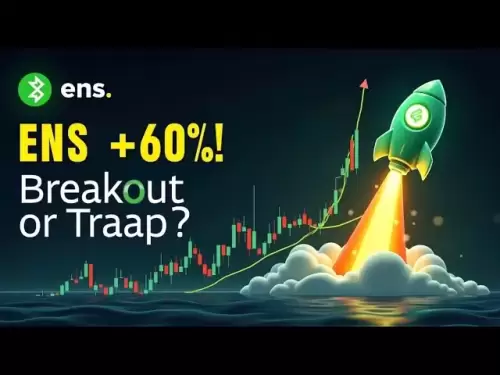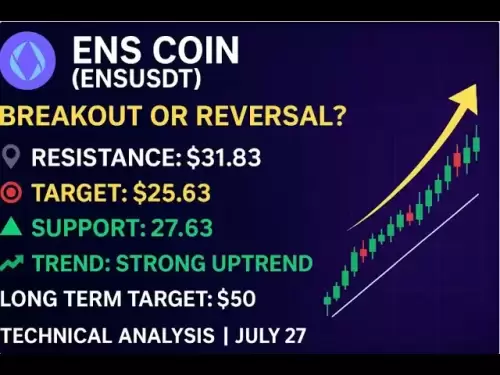-
 Bitcoin
Bitcoin $117900
0.31% -
 Ethereum
Ethereum $3766
0.28% -
 XRP
XRP $3.176
-0.31% -
 Tether USDt
Tether USDt $1.000
0.00% -
 BNB
BNB $795.6
1.51% -
 Solana
Solana $186.8
-1.09% -
 USDC
USDC $0.9999
-0.01% -
 Dogecoin
Dogecoin $0.2353
-1.33% -
 TRON
TRON $0.3226
1.49% -
 Cardano
Cardano $0.8172
-1.08% -
 Sui
Sui $4.178
3.06% -
 Hyperliquid
Hyperliquid $43.05
-3.39% -
 Stellar
Stellar $0.4367
-0.57% -
 Chainlink
Chainlink $18.62
1.47% -
 Hedera
Hedera $0.2828
6.63% -
 Bitcoin Cash
Bitcoin Cash $584.7
5.65% -
 Avalanche
Avalanche $24.81
2.53% -
 Litecoin
Litecoin $112.8
-0.88% -
 UNUS SED LEO
UNUS SED LEO $8.975
-0.08% -
 Shiba Inu
Shiba Inu $0.00001395
-1.07% -
 Toncoin
Toncoin $3.285
-1.05% -
 Ethena USDe
Ethena USDe $1.001
0.01% -
 Polkadot
Polkadot $4.123
0.76% -
 Uniswap
Uniswap $10.49
-0.18% -
 Monero
Monero $326.5
0.14% -
 Dai
Dai $0.9999
-0.02% -
 Bitget Token
Bitget Token $4.576
0.34% -
 Pepe
Pepe $0.00001247
-1.55% -
 Cronos
Cronos $0.1400
3.77% -
 Aave
Aave $295.1
-0.73%
How to leverage MEXC
Leverage trading on MEXC empowers traders with the ability to amplify potential returns while simultaneously increasing risks, necessitating careful consideration and proactive management.
Nov 13, 2024 at 03:54 pm

How to Leverage MEXC: A Comprehensive Guide to Unlocking Trading Opportunities
MEXC, a leading global cryptocurrency exchange, offers a comprehensive suite of trading tools and features to empower traders of all levels. One of its key offerings is leverage trading, which allows traders to amplify their potential returns by borrowing funds from the exchange. This can increase both profits and risks, so it's essential to understand how to leverage MEXC effectively.
Step 1: Determine Your Risk Tolerance
Leverage can be a double-edged sword, so it's crucial to assess your personal risk tolerance before engaging in leveraged trading. Consider your financial situation, investment goals, and ability to withstand potential losses. Remember that leverage magnifies both potential gains and losses, so only risk what you can afford to lose.
Step 2: Choose the Right Leverage Level
MEXC offers various leverage levels ranging from 1x to 10x. The optimal leverage level depends on your risk tolerance, trading strategy, and market conditions. Higher leverage levels provide greater potential returns but also amplify the risks. Start with a conservative leverage level and gradually increase it as you gain experience and confidence.
Step 3: Select a Trading Pair
MEXC offers leveraged trading on a wide range of trading pairs, including popular cryptocurrencies like Bitcoin, Ethereum, and USDT. Choose a trading pair that aligns with your trading strategy and market outlook. Research the market conditions, analyze technical charts, and consider the liquidity of the asset before selecting a trading pair.
Step 4: Place a Margin Order
To leverage trade on MEXC, you must use margin orders instead of regular spot orders. Select the "Margin Trading" tab in the trading interface and choose the appropriate leverage level. Enter the order details, including the order type, quantity, and price. Carefully review the order details before executing it.
Step 5: Monitor and Manage Your Position
Once your order is executed, it will appear in the "Margin Positions" section. Actively monitor your position by tracking the market price and adjusting your strategy as needed. Use stop-loss and take-profit orders to manage your risk and protect your profits.
Step 6: Repay the Loan
Leveraged trading involves borrowing funds from the exchange. You must repay the loan when you close your position. Ensure you have sufficient funds in your account to cover the repayment. Failure to repay the loan within the specified period may result in liquidation of your position.
Step 7: Consider Perpetually Funding
MEXC offers perpetual funding, which allows traders to extend the life of their leveraged positions without the need for active margin management. Traders can pay a funding fee to avoid liquidation in case of adverse price movements. Perpetual funding can provide greater flexibility in managing leveraged positions.
Step 8: Utilize Margin Trading Features
MEXC offers various features to enhance the margin trading experience. These include:
- Cross Margin: Allows traders to use the balance of multiple trading accounts as collateral for a single position.
- Isolated Margin: Isolates the collateral for each leveraged position, reducing the risk of cross-liquidation.
- Auto-Deleveraging: Automatically adjusts leverage levels in case of adverse price movements to prevent liquidation.
Step 9: Learn from Experienced Traders
Study the strategies and techniques of experienced leveraged traders to improve your trading skills. Follow successful traders, read industry publications, and attend webinars or workshops. Continuous learning can enhance your understanding of market dynamics and trading strategies.
Step 10: Practice in a Demo Account
Before experimenting with real funds, practice leveraged trading in a demo account. This allows you to familiarize yourself with the risks and mechanics of leveraged trading without risking any actual capital. Test different strategies, evaluate risk-reward ratios, and refine your trading plan in a safe and controlled environment
Disclaimer:info@kdj.com
The information provided is not trading advice. kdj.com does not assume any responsibility for any investments made based on the information provided in this article. Cryptocurrencies are highly volatile and it is highly recommended that you invest with caution after thorough research!
If you believe that the content used on this website infringes your copyright, please contact us immediately (info@kdj.com) and we will delete it promptly.
- Crypto ETFs and Altcoins: Navigating the Wild West with Meme Coins and Tokenized Assets
- 2025-07-27 23:04:06
- Pi Coin in 2026: Will It Be Worth the Wait?
- 2025-07-27 23:10:12
- Dogecoin Price Prediction: Bullish W Pattern Sparks Hope for $1 DOGE
- 2025-07-27 23:15:21
- Bitcoin Price, Portfolio Growth, and the Remittix Alternative: Navigating the Crypto Landscape
- 2025-07-27 23:04:06
- Cryptos to Watch in 2025: Punisher Coin, Chainlink, and the Altcoin Arena
- 2025-07-27 18:30:13
- Bitcoin, Altcoins, Rebound: Navigating the Crypto Comeback Trail
- 2025-07-27 18:30:13
Related knowledge

Why is my Bitstamp futures position being liquidated?
Jul 23,2025 at 11:08am
Understanding Futures Liquidation on BitstampFutures trading on Bitstamp involves borrowing funds to open leveraged positions, which amplifies both po...

Does Bitstamp offer inverse contracts?
Jul 23,2025 at 01:28pm
Understanding Inverse Contracts in Cryptocurrency TradingIn the realm of cryptocurrency derivatives, inverse contracts are a specific type of futures ...

What is the difference between futures and perpetuals on Bitstamp?
Jul 27,2025 at 05:08am
Understanding Futures Contracts on BitstampFutures contracts on Bitstamp are financial derivatives that allow traders to speculate on the future price...

How to find your Bitstamp futures trade history?
Jul 23,2025 at 08:07am
Understanding Bitstamp and Futures Trading AvailabilityAs of the current state of Bitstamp’s service offerings, it is critical to clarify that Bitstam...

Can I use a trailing stop on Bitstamp futures?
Jul 23,2025 at 01:42pm
Understanding Trailing Stops in Cryptocurrency TradingA trailing stop is a dynamic type of stop-loss order that adjusts automatically as the price of ...

Can I use a trailing stop on Bitstamp futures?
Jul 25,2025 at 02:28am
Understanding Trailing Stops in Cryptocurrency Futures TradingA trailing stop is a dynamic type of stop-loss order that adjusts automatically as the m...

Why is my Bitstamp futures position being liquidated?
Jul 23,2025 at 11:08am
Understanding Futures Liquidation on BitstampFutures trading on Bitstamp involves borrowing funds to open leveraged positions, which amplifies both po...

Does Bitstamp offer inverse contracts?
Jul 23,2025 at 01:28pm
Understanding Inverse Contracts in Cryptocurrency TradingIn the realm of cryptocurrency derivatives, inverse contracts are a specific type of futures ...

What is the difference between futures and perpetuals on Bitstamp?
Jul 27,2025 at 05:08am
Understanding Futures Contracts on BitstampFutures contracts on Bitstamp are financial derivatives that allow traders to speculate on the future price...

How to find your Bitstamp futures trade history?
Jul 23,2025 at 08:07am
Understanding Bitstamp and Futures Trading AvailabilityAs of the current state of Bitstamp’s service offerings, it is critical to clarify that Bitstam...

Can I use a trailing stop on Bitstamp futures?
Jul 23,2025 at 01:42pm
Understanding Trailing Stops in Cryptocurrency TradingA trailing stop is a dynamic type of stop-loss order that adjusts automatically as the price of ...

Can I use a trailing stop on Bitstamp futures?
Jul 25,2025 at 02:28am
Understanding Trailing Stops in Cryptocurrency Futures TradingA trailing stop is a dynamic type of stop-loss order that adjusts automatically as the m...
See all articles

























































































